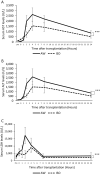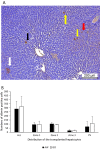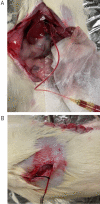Short-term inhalation of isoflurane improves the outcomes of intraportal hepatocyte transplantation
- PMID: 35273344
- PMCID: PMC8913608
- DOI: 10.1038/s41598-022-08237-6
Short-term inhalation of isoflurane improves the outcomes of intraportal hepatocyte transplantation
Abstract
Clinical hepatocyte transplantation (HTx) is only performed without general anesthesia, while inhalation anesthetics are usually used in animal experiments. We hypothesized that isoflurane may be a possible reason for the discrepancy between the results of animal experiments and the clinical outcomes of HTx. Syngeneic rat hepatocytes (1.0 × 107) were transplanted to analbuminemic rats with (ISO group) and without (AW group) isoflurane. The serum albumin, AST, ALT, LDH levels and several inflammatory mediators were analyzed. Immunohistochemical staining and ex vivo imaging were also performed. The serum albumin levels of the ISO group were significantly higher in comparison to the AW group (p < 0.05). The serum AST, ALT, LDH levels of the ISO group were significantly suppressed in comparison to the AW group (p < 0.0001, respectively). The serum IL-1β, IL-10, IL-18, MCP-1, RNTES, Fractalkine and LIX levels were significantly suppressed in the ISO group. The ischemic regions of the recipient livers in the ISO group tended to be smaller than the AW group; however, the distribution of transplanted hepatocytes in the liver parenchyma was comparable between the two groups. Isoflurane may at least in part be a reason for the discrepancy between the results of animal experiments and the clinical outcomes of HTx.
© 2022. The Author(s).
Conflict of interest statement
The authors declare no competing interests.
Figures







Similar articles
-
A novel approach for hepatocyte transplantation at the liver surface.Cell Transplant. 2025 Jan-Dec;34:9636897251329308. doi: 10.1177/09636897251329308. Epub 2025 Apr 10. Cell Transplant. 2025. PMID: 40208805 Free PMC article.
-
Preferable Transplant Site for Hepatocyte Transplantation in a Rat Model.Cell Transplant. 2021 Jan-Dec;30:9636897211040012. doi: 10.1177/09636897211040012. Cell Transplant. 2021. PMID: 34525872 Free PMC article.
-
Effects of edaravone, a radical scavenger, on hepatocyte transplantation.J Hepatobiliary Pancreat Sci. 2014 Dec;21(12):919-24. doi: 10.1002/jhbp.164. Epub 2014 Sep 10. J Hepatobiliary Pancreat Sci. 2014. PMID: 25205207
-
Intrasplenic hepatocyte transplantation prolonged the survival in Nagase analbuminemic rats with liver failure induced by common bile duct ligation.Cell Transplant. 2007;16(5):547-53. doi: 10.3727/000000007783464894. Cell Transplant. 2007. PMID: 17708344
-
Selective intraportal hepatocyte transplantation in analbuminemic and Gunn rats.Transplantation. 1993 Jun;55(6):1213-9. doi: 10.1097/00007890-199306000-00002. Transplantation. 1993. PMID: 8516804
Cited by
-
A novel approach for hepatocyte transplantation at the liver surface.Cell Transplant. 2025 Jan-Dec;34:9636897251329308. doi: 10.1177/09636897251329308. Epub 2025 Apr 10. Cell Transplant. 2025. PMID: 40208805 Free PMC article.
References
-
- Graziadei I, et al. Indications for liver transplantation in adults : Recommendations of the Austrian Society for Gastroenterology and Hepatology (ÖGGH) in cooperation with the Austrian Society for Transplantation, Transfusion and Genetics (ATX) Wien Klin. Wochenschr. 2016;128:679–690. doi: 10.1007/s00508-016-1046-1. - DOI - PMC - PubMed
Publication types
MeSH terms
Substances
LinkOut - more resources
Full Text Sources
Medical
Research Materials
Miscellaneous

